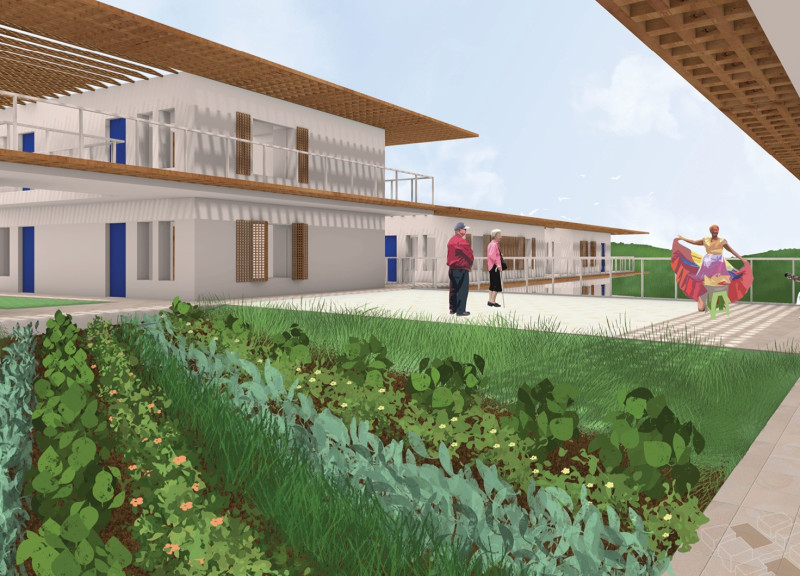5 key facts about this project
The architectural design offers a layout that prioritizes accessibility and engagement with the surrounding environment. The central feature of the site is a beautifully landscaped garden that acts as the communal heart of the community, fostering social interactions among residents and visitors alike. This space is complemented by a series of exterior walkways that guide residents through various outdoor areas, making the experience of navigating the site both enjoyable and supportive of physical activity. The thoughtful arrangement of courtyards enhances the natural light within the residential units, promoting a serene atmosphere that is essential for the well-being of the elderly inhabitants.
Important architectural elements include a blend of durability and warmth, achieved through a deliberate selection of materials. The use of concrete in structural applications ensures that the buildings will endure the test of time while providing necessary thermal mass. Wooden roofing elements add a layer of warmth to the overall aesthetic, creating an inviting atmosphere that contrasts with the solidity of the concrete. The extensive use of glass throughout the design maximizes natural light and visual connections to the outdoors, facilitating a seamless transition between indoor and outdoor spaces. The incorporation of durable stone and tile flooring is another practical choice, allowing for easy maintenance while enhancing the aesthetic appeal of the interior spaces.
Unique design approaches distinguish Aldeia Florada from other elderly care facilities. The project celebrates a strong connection to the local environment, featuring native vegetation that not only enhances biodiversity but also offers a source of nutrition with plants like Dwarf Lemon and Dwarf Almond incorporated within the site's gardens. This ecological aspect not only supports the well-being of the residents but also emphasizes the importance of sustainable practices in modern architecture. Each housing unit is designed with flexibility in mind, offering shared courtyards that encourage neighborly connections and recreational opportunities for residents.
Additionally, the project takes into account the varied needs of its occupants by ensuring that all design elements are accessible. Navigating through the spaces, residents can comfortably engage in activities such as gardening, social gatherings, and participating in creative hobbies within dedicated communal areas, including spaces for workshops and a library. The deliberate integration of these design features creates a vibrant community atmosphere that counters the isolation often experienced in traditional care facilities.
Aldeia Florada embodies a holistic approach to architecture that values the intersection of community and nature. By prioritizing natural connections, the project promotes physical health and emotional well-being through thoughtful engagement with the outdoors and a supportive community environment. The combination of innovative design ideas, practical material choices, and a focus on sustainability makes this project a noteworthy example of contemporary architecture in the context of elder care.
For a deeper understanding of Aldeia Florada and its architectural significance, readers are encouraged to explore the detailed architectural plans, sections, designs, and ideas presented within the project. Engaging with these materials will provide valuable insights into the design philosophy and the careful considerations that went into creating this nurturing and supportive living environment.


























